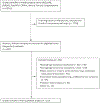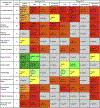Childhood Risk Factors and Adulthood Cardiovascular Disease: A Systematic Review
- PMID: 33516680
- PMCID: PMC11583247
- DOI: 10.1016/j.jpeds.2021.01.053
Childhood Risk Factors and Adulthood Cardiovascular Disease: A Systematic Review
Abstract
Objective: To conduct a comprehensive review of the literature on childhood risk factors and their associations with adulthood subclinical and clinical cardiovascular disease (CVD).
Study design: A systematic search was performed using the MEDLINE, EMBASE, PsycINFO, CINAHL, and Web of Science databases to identify English-language articles published through June 2018. Articles were included if they were longitudinal studies in community-based populations, the primary exposure occurred during childhood, and the primary outcome was either a measure of subclinical CVD or a clinical CVD event occurring in adulthood. Two independent reviewers screened determined whether eligibility criteria were met.
Results: There were 210 articles that met the predefined criteria. The greatest number of publications examined associations of clinical risk factors, including childhood adiposity, blood pressure, and cholesterol, with the development of adult CVD. Few studies examined childhood lifestyle factors including diet quality, physical activity, and tobacco exposure. Domains of risk beyond "traditional" cardiovascular risk factors, such as childhood psychosocial adversity, seemed to have strong published associations with the development of CVD.
Conclusions: Although the evidence was fairly consistent in direction and magnitude for exposures such as childhood adiposity, hypertension, and hyperlipidemia, significant gaps remain in the understanding of how childhood health and behaviors translate to the risk of adulthood CVD, particularly in lesser studied exposures like glycemic indicators, physical activity, diet quality, very early life course exposure, and population subgroups.
Keywords: hypertension; life course; obesity; prevention; subclinical.
Copyright © 2021 Elsevier Inc. All rights reserved.
Figures



References
-
- Benjamin EJ, Muntner P, Alonso A, Bittencourt MS, Callaway CW, Carson AP, et al. Heart disease and stroke statistics-2019 update: a report from the American Heart Association. Circulation 2019;139:e56–528. - PubMed
-
- McGill HC Jr, McMahan CA, Herderick EE, Malcom GT, Tracy RE, Strong JP. Origin of atherosclerosis in childhood and adolescence. Am J Clin Nutr 2000;72:1307s–15s. - PubMed
-
- Expert Panel on Integrated Guidelines for Cardiovascular Health and Risk Reduction in Children and Adolescents, National Heart, Lung, and Blood Institute. Expert panel on integrated guidelines for cardiovascular health and risk reduction in children and adolescents: summary report. Pediatrics 2011;128:S213–56. - PMC - PubMed
Publication types
MeSH terms
Grants and funding
LinkOut - more resources
Full Text Sources
Other Literature Sources
Miscellaneous

